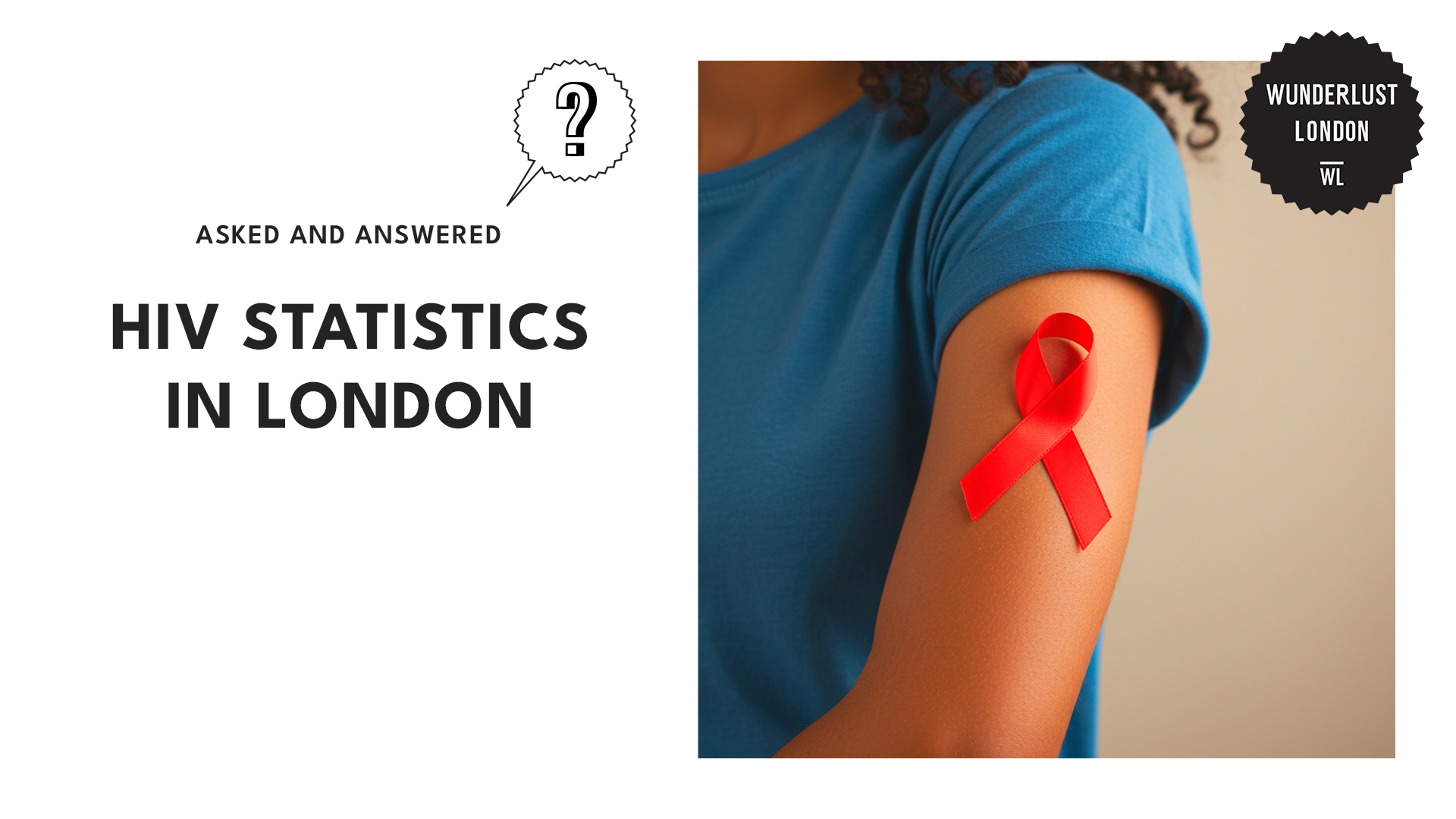Key Insights
- According to the UK government, almost 38,680 people were living with HIV in London in 2022.
- Based on reports, black African individuals had a highest percentage of HIV diagnoses at 60%. Meanwhile, white people had the lowest percentage of late HIV diagnoses at 30%.
- The London HIV annual spotlight 2022 report presents data that shows the age group of 35 to 44 has the highest new HIV diagnoses, with 260 in 2013 and 121 in 2022.
- Data from the UK government reveals that the most common route of new HIV diagnoses in London has consistently been through sex between men (SBM) from 2013 to 2022.
According to the UK government, almost 38,680 people were living with HIV in London in 2022. The government reveals that this number increased by 1,543 in 2023.
London’s government attributes this increase to the success of HIV treatment, which has significantly reduced the death of people with HIV.
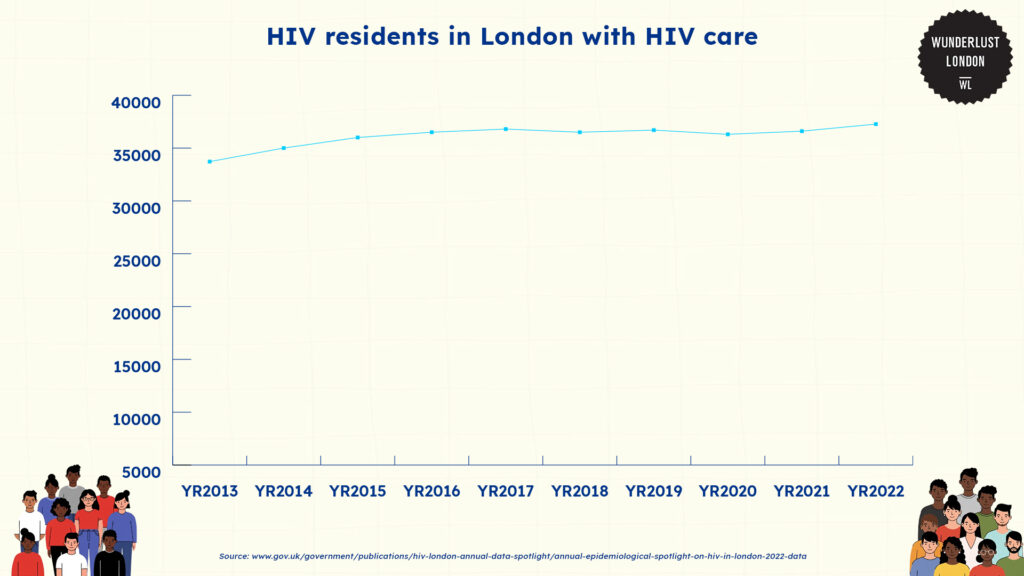
The line graph based on government data displays the number of London residents with HIV who had HIV-related care between 2013 and 2022.
The annual epidemiological spotlight on HIV in London shows an increase in diagnosed HIV prevalence. It starts at 33,718 in 2013 but peaks at 37,188 in 2019.
Although the number slightly decreased to 36,581 in 2020, by 2022, it had risen to 37,267.
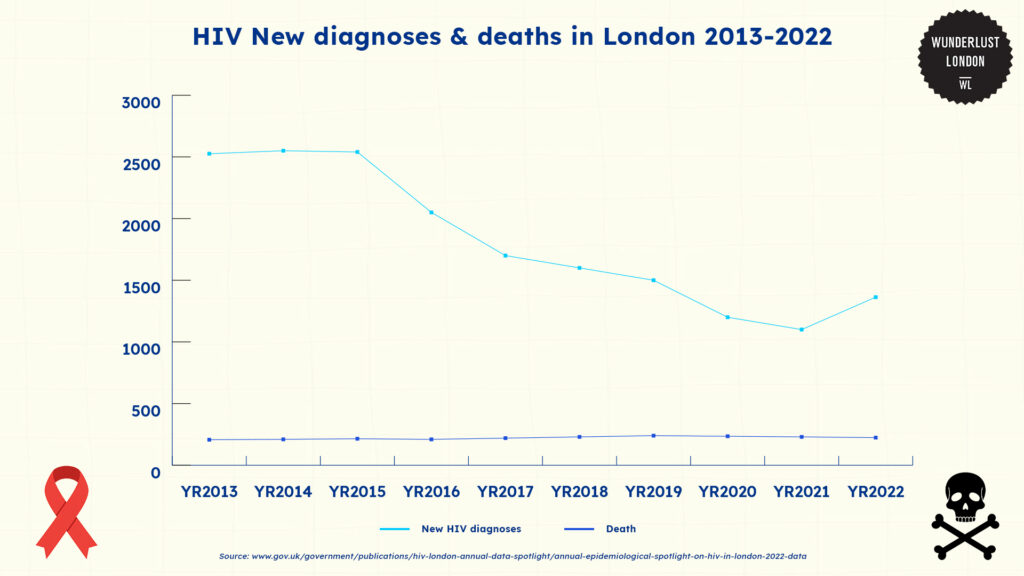
Based on the data provided by the United Kingdom Government, new HIV diagnoses and deaths varied among people in London from 2013 to 2022.
The red line shows the number of new HIV diagnoses each year, which shows a clear downward trend. In 2013, there were 2,526 new cases. The number steadily declined yearly, reaching an estimated low of 1,163 in 2021 before slightly increasing to 1,363 in 2022.
This decline suggests that efforts to prevent HIV transmission in London have been largely effective over this period.
The blue line represents the number of deaths among people with HIV in London. Unlike new diagnoses, the number of deaths remained relatively stable, ranging between approximately 200 and 300. In 2013, there were 207 recorded deaths, with a slight increase to 224 in 2022.
While people with HIV are still dying, the relatively steady numbers likely reflect advancements in HIV treatment and care. The advancement has enabled those living with the virus to lead longer and healthier lives.

According to Fast Track Cities London, London is reaching key targets for HIV care. The data on the graph shows the percentage at each step: diagnosis, being on treatment, and achieving viral suppression.
The bars represent the percentages in London, while the lines indicate the UNAIDS 90:90:90 targets.
- People living with HIV: The first bar represents 100%, which reflects the estimated total number of people living with HIV in London.
- People diagnosed with HIV: The second one shows 96% of all people living with HIV in London have been diagnosed.
- On treatment: The third bar indicates that 94% of those diagnosed with HIV in London are receiving antiretroviral treatment.
- Virally suppressed: The final bar shows that 92% of people on treatment in London have achieved viral suppression, meaning the level of HIV in their blood is so low it’s undetectable. This is essential for their health and prevents further transmission of HIV.
Geographic distribution of HIV statistics in London
London’s HIV statistics per 1,000 population
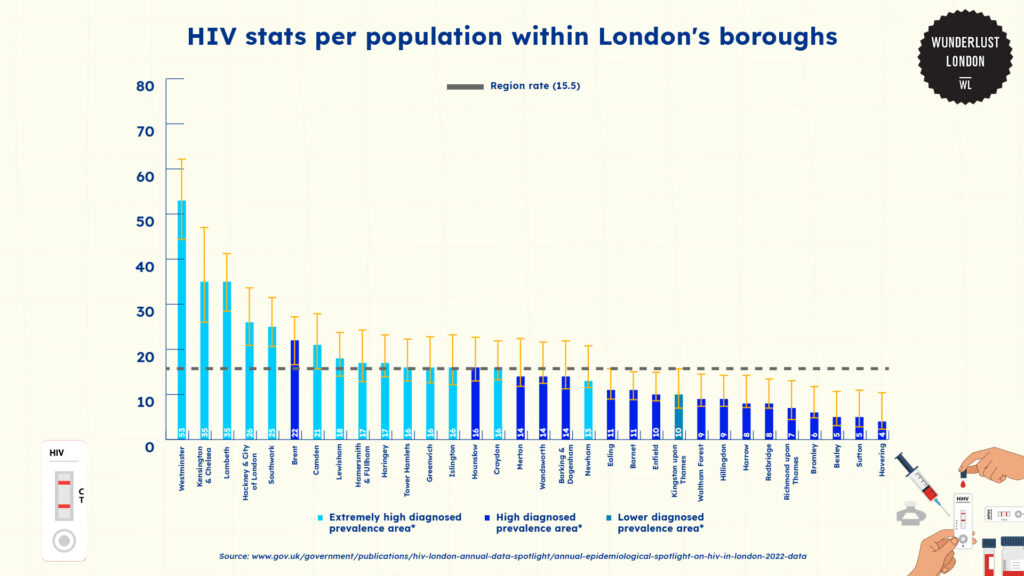
The Annual Epidemiological Spotlight on HIV in London research of the government shows that the number of new HIV diagnoses per 100,000 people across different London boroughs varies significantly.
The average rate for London as a whole is 15.5 new diagnoses per 100,000 people. While some boroughs fall below this average, some have significantly higher rates.
The area with the highest prevalence of new HIV diagnoses is Westminster, with 53 new diagnoses per 100,000 people. Kensington & Chelsea, Lambeth, Hackney & City of London, and Southwark also have a similarly high prevalence.
Other boroughs with high prevalence but slightly lower rates include Brent, Camden, Lewisham, Hammersmith & Fulham, Haringey, Greenwich, and Islington.
Havering recorded the lowest prevalence out of all the boroughs, with only 4 new cases per 100,000 people. Sutton and Bexley also have low prevalence, with both having only 5 new cases per 100,000 people.
London’s late HIV diagnoses by local areas
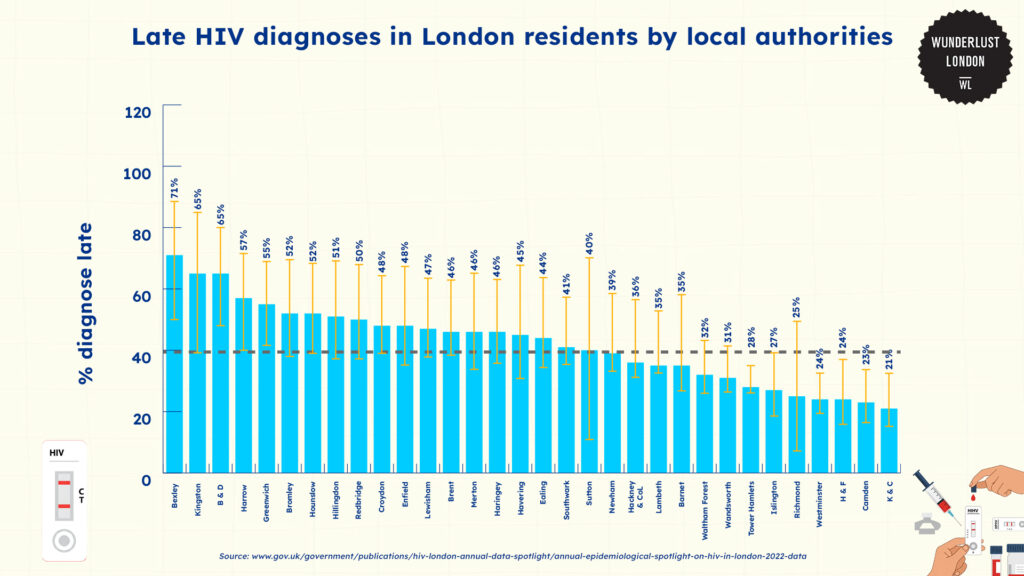
The same research reveals that, on average, 39.4% of HIV diagnoses in London are made late, meaning the infection has already progressed to a more advanced stage before being detected.
Bexley has the highest percentage of late diagnoses, with around 71% of diagnoses occurring late. Other boroughs with a higher percentage than the London average include Kingston, Harrow, and Barking and Dagenham.
Boroughs with a lower percentage of late diagnoses include Lambeth, Barnet, Wandsworth, and K&C (Kensington & Chelsea boroughs). K & C has the lowest percentage, with only about 21% of diagnoses being late.
London HIV diagnoses by index of multiple deprivation
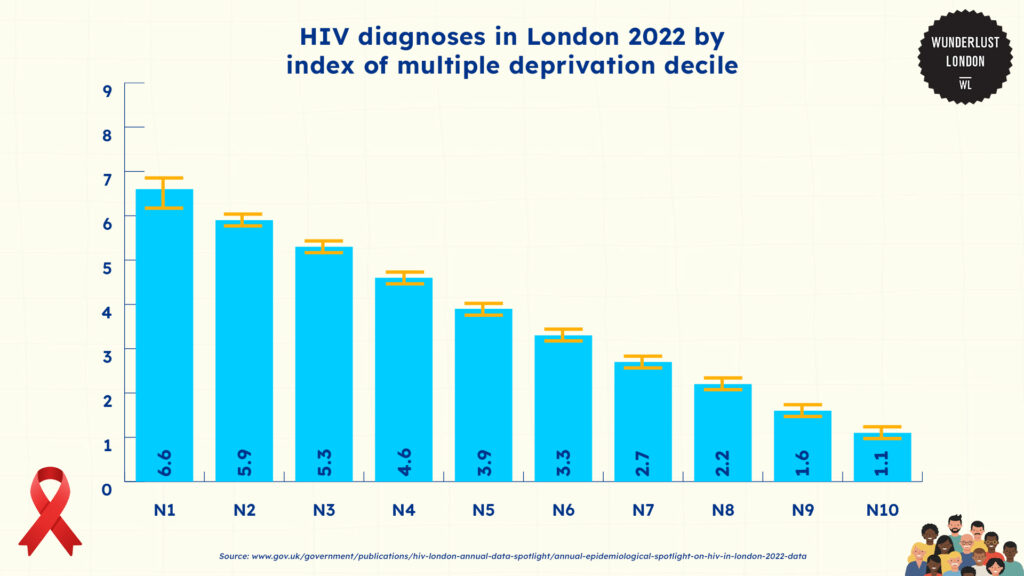
According to the UK government, HIV diagnoses vary across areas of different levels of deprivation. Deprivation here means that an area is disadvantaged based on income, employment, health, and education.
London is divided into 10 deciles based on deprivation levels. Decile 1, the most deprived area, has the highest rate of HIV diagnoses at 6.6 per 100,000 population. Meanwhile, Decile 10 has the lowest at 1.1 per 100,000.
The research reveals that as the level of deprivation decreases, the rate of new HIV diagnoses also decreases. This highlights a strong link between socio-economic factors and the likelihood of being diagnosed with HIV in London.
Demographic breakdown of HIV cases in London
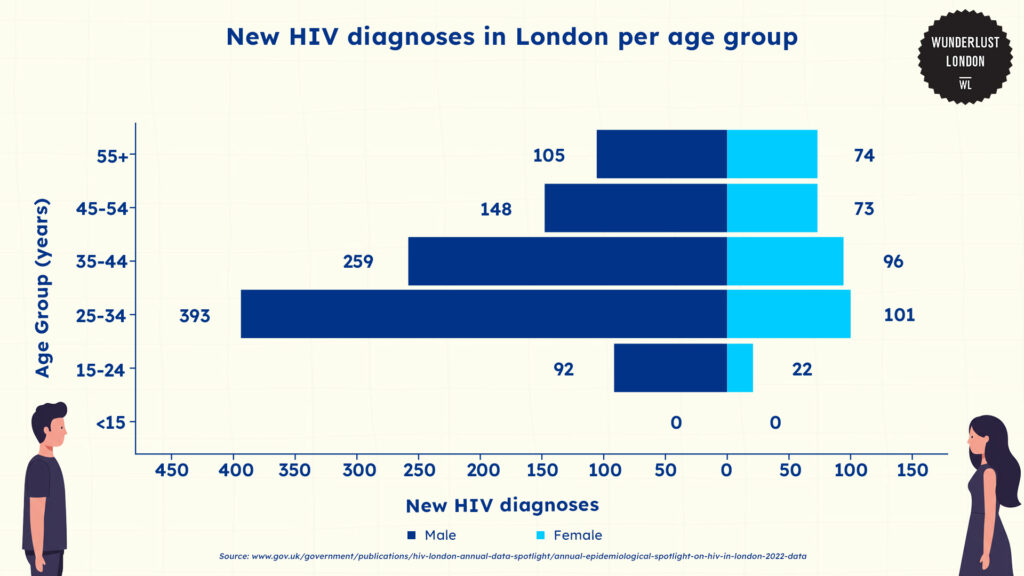
The 2022 Annual Epidemiological Spotlight on HIV in London research of the government gives us a clear picture of which demographic groups are most affected by new HIV infections.
The data shows that HIV diagnoses are more common in males than females across nearly all age groups.
The 25-34 age group has the highest number of new HIV diagnoses overall for both genders. Men had 393 new diagnoses, and there were 101 new diagnoses for females in this age group.
In contrast, the 15-24 age group has the lowest number of diagnoses, with 92 diagnoses in males and 22 in females.
Percentage of London HIV residents accessing care per age group
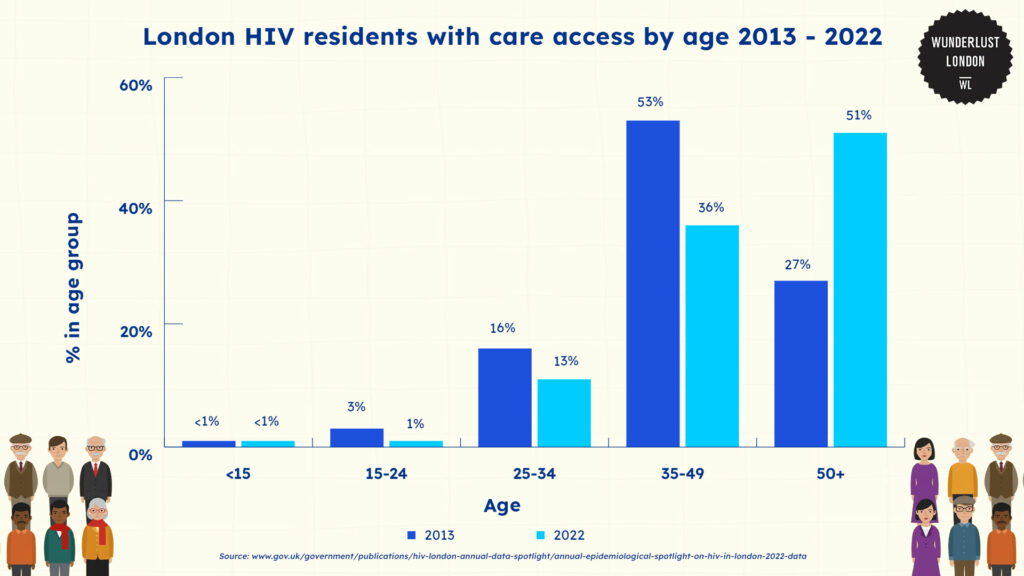
In both 2013 and 2022, people under 15 years old made up less than 1% of those accessing HIV care in London, as per the data revealed by the UK government.
In 2013, the largest group accessing care was those aged 35-49, at 53%. However, this decreased to 36% in 2022.
Meanwhile, the percentage of people aged 50 and older increased significantly, from 27% in 2013 to 51% in 2022.
Younger age groups had lower access to care. Among 15- to 24-year-olds, the percentage decreased slightly from 3% in 2013 to 1% in 2022. Similarly, the percentage of people aged 25 to 34 accessing care decreased from 16% in 2013 to 11% in 2022.
New HIV diagnoses in London by ethnic group
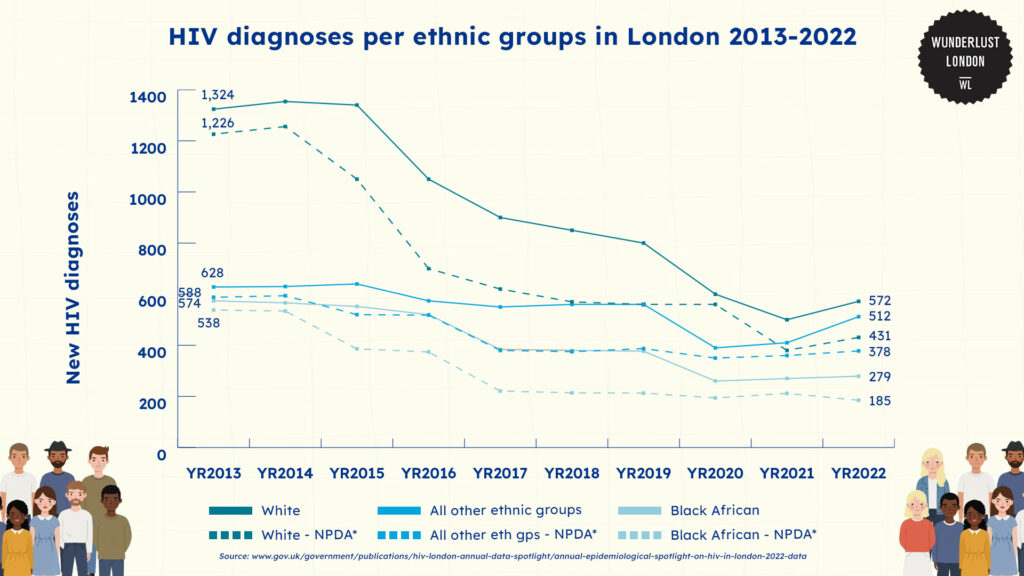
The UK government also revealed that there was a decline in new HIV diagnoses across different ethnic groups in London from 2013 to 2022.
Among the white ethnic group, diagnoses were the highest in 2013 at 1,324. However, they decreased over the decade, falling to 572 in 2022.
The black African ethnic group also saw a decline, with new diagnoses falling from 574 in 2013 to 279 in 2022.
Meanwhile, diagnoses among other ethnic groups showed a slight decrease from 628 in 2013 to 512 in 2022.
Late HIV diagnoses in London by ethnic groups
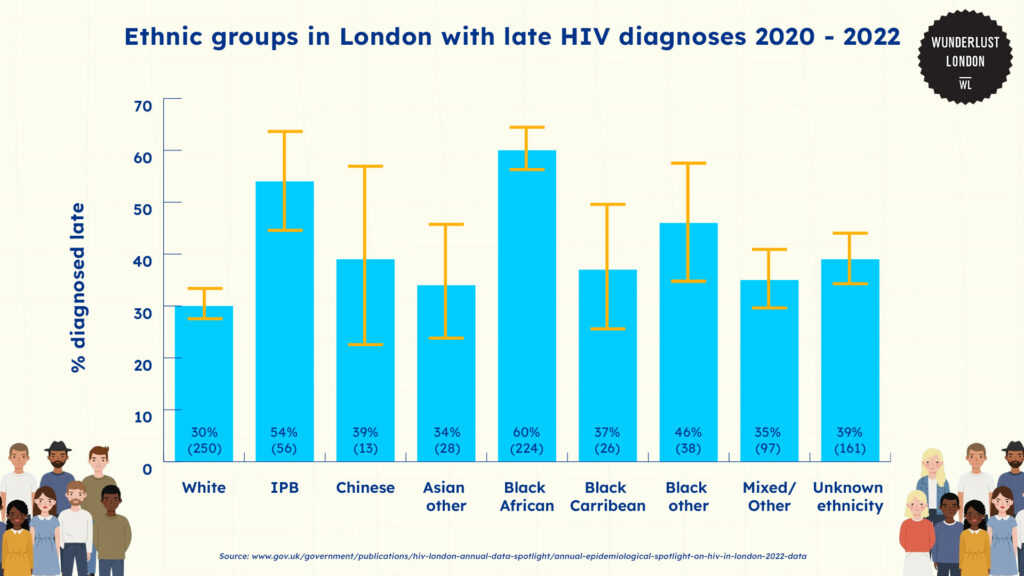
According to research from the UK government, rates of late HIV diagnoses in the overall population of London varied among residents of different ethnic groups aged 15 and over between 2020 and 2022.
People from black African and IPB (Indian, Pakistani, Bangladeshi) communities were more likely to be diagnosed late, while white individuals were the least likely to be diagnosed late.
Black African individuals make up more than half of late diagnoses, 60% (224 people) receiving their diagnosis at a late stage. Individuals from IPB communities follow closely, with 54% (56 people) diagnosed late.
In contrast, white people had the lowest percentage of late diagnoses at 30% (250 people).
HIV transmission routes statistics in London
Statistics of probable routes of acquiring HIV in London

Data from the UK government reveals that the most common route of new HIV diagnoses in London has consistently been through sex between men (SBM) from 2013 to 2022.
In 2013, there were 1,548 new HIV diagnoses. However, in 2022, there were only 654. While there was a decrease, this transmission route still remained the highest when compared to other ways.
The number of new diagnoses through heterosexual sex was slightly lower than through sex between men. The rate was 1,463 in 2013 but lowered to 650 in 2022.
The “Other infection routes” such as injecting drug use or mother-to-child transmission, accounts for the smallest proportion of new HIV diagnoses. Statistics show this route went from 86 new diagnoses in 2013 to 49 in 22.
New HIV diagnoses by age group transmitted through MF sex
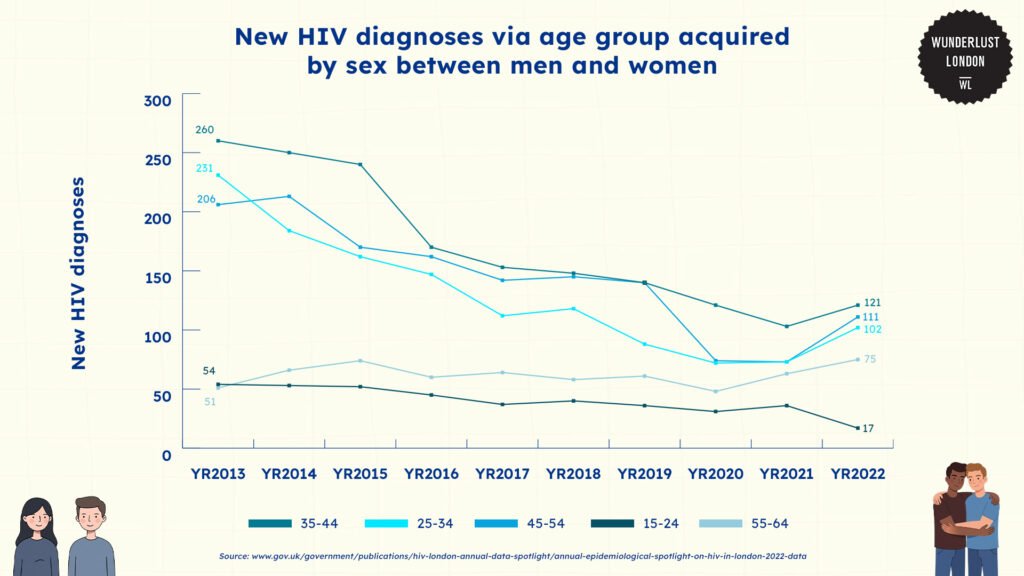
Based on the London HIV annual spotlight 2022 report, the age group of 35 to 44 has the highest new HIV diagnoses, with 260 in 2013 and 121 in 2022.
Among those aged 45-54, diagnoses also declined, from 206 in 2013 to 111 in 2022.
The 25-34 age group saw a similar trend, with cases falling from 231 new HIV diagnoses in 2013 to 102 in 2022.
Meanwhile, the oldest age group (55-64) was the only category to see an increase. Diagnoses rose from 54 in 2013 to 77 in 2022.
The youngest age range (15-24) had consistently lower numbers, with 54 cases in 2013 and 17 new ones in 2022.
Late HIV diagnoses in London 15 years and older via infection routes

The UK government broke down late diagnoses by the likely way HIV was transmitted in 2020 to 2022 in its report.
The data focuses on four main ways: 1) Sex between men, 2) Heterosexual contact (Male), 3) Heterosexual contact (Female), and 4) Injecting drug use.
Heterosexual contact – Males had the highest percentage of late diagnoses at 60% (222 individuals). This means that men acquiring HIV through heterosexual contact are more likely to be diagnosed at a later stage.
Heterosexual contact – Females also had a high percentage, at 56% (215 individuals).
Meanwhile, sex between men had the lowest percentage of late diagnoses, at 29% (204 individuals).
The percentage of late diagnoses was high (55%) for people who caught HIV by injecting drug use. But the number of people is smaller than the rest—only 11 people.
Public health interventions of HIV in London

Based on NHS UK, there are many effective ways to prevent or reduce the risk of HIV infection, including:
- Using a condom for sex
- Treatment for HIV to reduce the viral load to undetectable
- If you use drugs, never share needles or other injecting equipment. This includes syringes, spoons, and swabs.
The UK government has put together an HIV Action Plan to reduce HIV transmission by 80% and HIV-related deaths and diagnoses by 50%.
One way the government has put HIV prevention into action is by expanding community testing, focusing on groups that are more likely to benefit, such as ethnic minority populations.
The HIV action plan also intends to make it easier to identify the drivers of late diagnosis to improve interventions and create smooth pathways into care for people diagnosed late or abroad.
So far, England has already achieved the UNAIDS 2025 targets. This means that:
- 95% of people with HIV have been diagnosed
- 95% of those diagnosed are receiving treatment.
- 95% of those on treatment have a suppressed viral load and cannot pass on the virus
The mayor of London declared that London was the first city in England to establish opt-out HIV testing in all emergency departments, leading to hundreds of people living with HIV knowing their status and accessing treatment.
References
- Annual epidemiological spotlight on HIV in London: 2022 data. (2024, August 8). GOV.UK. https://www.gov.uk/government/publications/hiv-london-annual-data-spotlight/annual-epidemiological-spotlight-on-hiv-in-london-2022-data
- HIV Action Plan monitoring and evaluation framework 2024 report. (2025, February 17). GOV.UK. https://www.gov.uk/government/publications/hiv-monitoring-and-evaluation-framework/hiv-action-plan-monitoring-and-evaluation-framework-2024-report
- HIV on the rise in the capital. (n.d.). London City Hall. https://www.london.gov.uk/hiv-rise-capital
- Website, N. (2024, November 12). HIV and AIDS. nhs.uk. https://www.nhs.uk/conditions/hiv-and-aids/
- Questions to the mayor. London City Hall. (2024, November 26). https://www.london.gov.uk/who-we-are/what-london-assembly-does/questions-mayor


